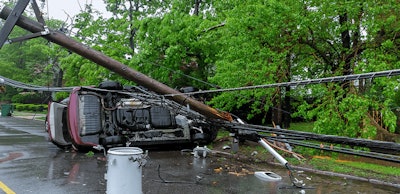
Mother Nature’s summer plans
By ALLISON ROGERS
I have recently developed a personal interest in the weather. Keeping eyes on weather radars, storm patterns and tracking systems as they approach my locale—I’d classify myself as a real hobbyist-in-training.
My interest was furthered by Ontario’s recent whopper of a storm, which killed power at the Media Matters offices for more than three days—up to a week in other regions. Nearly 2,000 hydro poles were knocked to the ground and, in places like Ottawa and the small town of Uxbridge, Ont., vehicles were tossed around by derecho winds like Hot Wheels cars. The Insurance Bureau of Canada (IBC) has yet to estimate the cost of such damages but is expecting an avalanche of claims.
Canadians are no strangers to severe weather phenomena, especially in the most sought-for season. Simply look at last year’s events for a brief history of British Columbia’s experience with severe weather. Meanwhile, hailstorms and tornadoes are common threats to Albertan summers, with more than 100 severe weather reports and 1,500 watches or warnings issued each summer. Saskatchewan Government Insurance recently revealed that last year’s end-of-summer hailstorm in Regina spurred more than $100 million in claims. Atlantic Canadians, on the other hand, often reap the treasures of the tropical storm season. Those in the West are in for a quieter summer, according to the Weather Network’s predictions. The rest of Canada, not as much.
According to the channel’s national summer forecast, we’re in for a season of “sun and storms,” with widespread warm weather—most of Canada will see nearnormal or above-normal temperatures—but the heat will be interrupted by storms and other severe systems. The channel predicts drought and typical precipitation levels for British Columbia and Alberta; minimizing the risk of wildfire smoke, said the Weather Network. Saskatchewan and Manitoba will see a more back-and-forth trend, with heatwaves broken by periods of excessive rainfall—something Manitoba has already dealt with in droves this season.
Québec and Ontario can both expect warm, humid temperatures, but must also be prepared for significant storms and rainfall. Nothing like the May 21 derecho storm, but only time will tell the severity of the systems. The Maritimes will see similar trends, with La Niña phenomena playing a key role in precipitation rates. With La Niña’s tendency to favour above normal and active hurricane seasons, the Weather Network suggests that Atlantic provinces could see tropical storm trends as early as June.
Peculiar summer weather trends aside, most Canadians are also recovering from a two-year case of cabin fever. There are surveys aplenty predicting the number of Canadian drivers planning summer road trips; Toyota Canada’s summer stats say 43 percent of Canadian drivers are more than ready to travel outside of their home province, while 24 percent are planning to travel abroad. Recent hikes in gas prices may stifle those numbers a tad, but when the two options are to spend another weekend at home or plan a getaway…what would you pick?
No mathematician or otherwise can answer the question that befalls us now: what does two years of hometown claustrophobia, plus a season of wacky weather have in store? We’re about to find out.





















